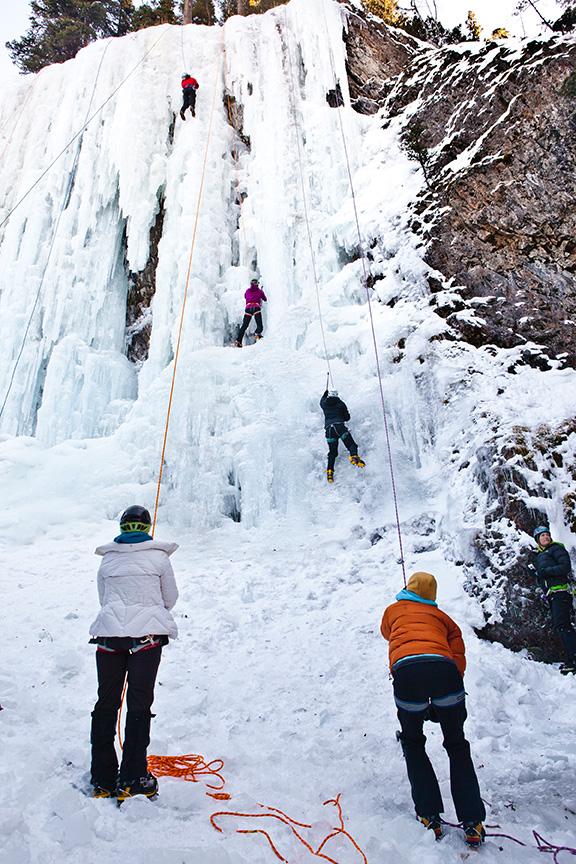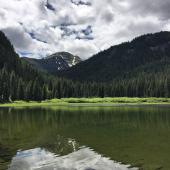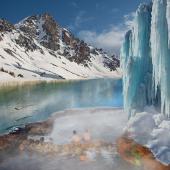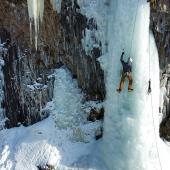On Belay
Bozeman Ice Fest clinic areas.
Hyalite holds a lifetime of ice and mixed climbs to discover. Ice Fest clinics take place at just four of the core venues: Genesis, Mummy, Amphitheater, and Unnamed Wall. Although I recommend exploring other areas like Twin Falls, Dribbles, Winter Dance, East Fork, and Flanders, there are good climbs to be found in the core areas, despite their occupancy by Ice Festers. This overview of Genesis, Unnamed Wall, and Mummy will help you get started—whether it’s before, during, or after the festival.
For the 2021 Ice Fest, there will be shuttles running from the new parking lot near Chisholm Campground to the Grotto Falls Trailhead. This will help eliminate congestion at the trailhead.
Area 1: Genesis
Reliable ice, easy access, and convenient top-roping on everything from slabs to vertical terrain make Genesis 1 (aka, G1 Wall) the most popular ice-climbing venue in Montana. Recent emphasis on mixed climbing has fleshed out the route selection all along the G1 Wall to provide a little something for everyone.
Approach. The approach to G1 Wall is unmarked but obvious by the well-worn trail in the northeast corner of the Grotto Falls parking lot. Fifteen minutes uphill deposits you directly at the right side of G1 Wall. To reach G2, continue upward to the top of the G1 area and follow the drainage to arrive at the route on the right side. Most people set up top-ropes here, but it takes an understanding of anchor systems and some familiarity with the top of the G1 Wall to set up safely. If in doubt, hire a guide or find a qualified friend.
Ice Fest Locations. The Ice Fest traditionally uses the entire G1 Wall, starting on Willow Gully and occupying everything to the right, including the mixed routes on the far right side of the wall. The G1 Wall typically forms into four main ice flows. The shorter routes on the left are lower-angled (read: easier) and the first to form. The routes will get steeper and longer as you move right across the wall, with the center right offering freehanging icicles that may take weeks or months to form completely. The last ice on the right side of the G1 Wall often holds interesting formations that make for some of the most interesting climbing on the wall. The shape, size, and consistency of all these routes will change dramatically throughout the winter. It is important in the early season to give icicles time to form completely. Once they touch down they will grow rapidly and create much better climbing for everyone. Climbing on tenuous features or knocking icicles down is considered bad form and dangerous for others. No one will think you are a “bad ass” by wailing on things and knocking down lots of ice.
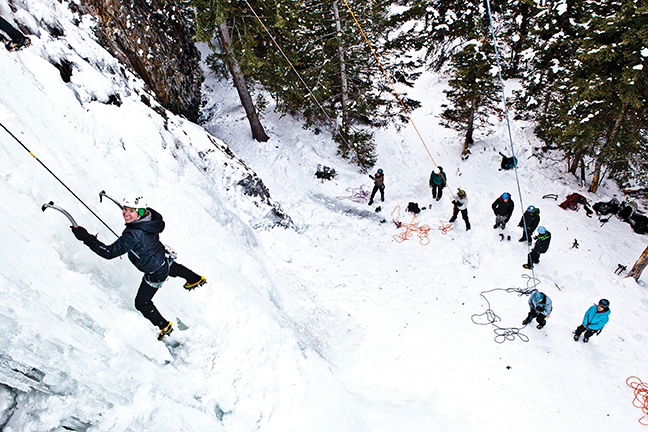 Clinics on G1
Clinics on G1
Other Routes. There are some good mixed climbs found on either side of the main G1 Wall that are not usually occupied by the Ice Fest. The next two tiers above are wide open to the public and provide opportunities to tick a handful of routes in an easy day.
First-Tier Mixed Climbs. Immediately right of G1 are a few recently bolted mixed routes. This is a good place to progress into steeper dry-tooling on climbs like Short and Sweet (M5), Blackalicious (M7), and Obama (M9)—bolted by Conrad Anker on Obama's last day in office.
Mixed climbing at G1 in Hyalite. Image by Bob Allen / MT 360.
About a rope-length left of G1 is the diminutive Clump Tree Gully at the top of the hump. Just left is the obvious wide crack Deadfall Crack (15m, M5 R), Catholic Boyfriend (25m, M9) cutting through a steep roof, and My Jewish Girlfriend (35m, M4) starting at the lowest point. Protection bolts might be hard to find if covered in snow, but you’ll see them once you start scraping up the route.
Scottish Cliff (30m, 5.4-5.6 mixed). This cliff, low-angled and highly featured, is to the right of the trail leading around the right side of G1, offering mixed climbing more like you might find on a mountaineering route than a steep “M-rated” climb. There are likely no moves on the wall harder than 5.6, with most of it closer to 5.4. The climbing is quite fun, much harder when covered with snow, and should become a popular venue for learning rock climbing with crampons and tools.
The routes generally get harder and shorter from left to right. All have fixed anchors and most require at least a 30m rope to top-rope. They were bolted on lead so they aren’t sewn up, but they typically have a bolt where you want them. From left to right, the routes are Jacobite Rising, No Hawkers or Campbells, Single Malt, Teardrop of Water, and Speyside.
Second-Tier Ice Climbs. Here you will find a number of classic WI 3 pitches: Genesis II, Hangover, and Upper Greensleeves (three variations). From G1, you can walk around the right side and continue up the drainage directly to Genesis II. You can also walk around the far left side of the G1 Wall near Lower Greensleeves (WI 2) and pound uphill directly to Hangover. An exposed traverse between G2 and Hangover makes for a great circuit. The new Light & Fast seminars will use these 2nd-tier routes to simulate multiple-pitch routes and moving across terrain like you might on a mountaineering routes. Depending on the season, there are half a dozen high-end (M6 to M9) mixed climbs on the Hangover Buttress. If formed, they may be seen as yellow smears and intriguing drips in the alcoves between Genesis II and Hangover.
Area 2: Unnamed Wall
With up to three-dozen routes on a mile-long wall, this area is deservedly popular and offers a wide variety of routes throughout the climbing season. Most seasons, only 6-10 routes form, with most not visible from the parking lot. A strong traditional mixed-climbing era in the 1990s led by Alex Lowe, followed by a bolted drytooling wave that has swept the sport in the past ten years, has made the Unnamed Wall home to some of the hardest routes in the world. Fortunately for us mere-mortals, there are a host of easy to moderate pure ice and mixed climbs that are among the best in the canyon.
Approach. From the Grotto Falls trailhead, hike a short distance to a meadow and a trail to the right (west) and down to the creek. Cross the creek and traverse around the bank, then angle left up a wide drainage that leads up the hill to the Bingo Cave in the middle of the wall. Approach times vary depending on snow conditions, but allow 25-45 minutes. Bingo Cave is almost always buzzing with drytoolers in the massive cave or on the walls to the side. Be careful of rockfall generated from climbers above.
Ice Fest Locations. The Ice Fest runs clinics on Unnamed Wall, but activity is limited to a few condition-dependent routes. Most often we are set up right of the Bingo Cave starting at The Good Looking One (WI 5) and including Jeff’s Left and Right (WI 3+ mixed) to Magically Delicious (M5). Occasionally, clinics are held left of the Bingo Cave starting at The Thrill is Gone (M4) and left on the Original Unnamed Routes (thin WI 3-4). The two-day rescue clinic will take place at The Fat One (WI 3) on Saturday and Sunday only.
Other Routes. There are some great routes available to the general public during the Ice Fest including some classic ice and burly inverted drytooling.
The Original Unnamed Routes. Between The Thrill is Gone and The Fat One are up to four potential smears. These were all originally done in the 1980s by Alex Lowe and Jack Tackle, but at the time weren’t considered to be “real” routes and went unnamed, leading to the wall’s moniker. They may not even be visible some years, but right to left they are: Itchy and Scratchy Show (WI 3+ R), On the Fly (WI 2), The Scrappy One (WI 3+) and The Anorexic One (WI 2), immediately right of The Fat One. There are some newer M4 to M5 bolted routes on the steep clean walls between these ice routes and all are recommended.
Elevator Shaft (35m, WI 3+). This route is one of the classics of Hyalite and deservedly popular. If you are truly looking to get away from Ice Fest crowds, follow the drainage upward for 30-45 minutes to find a collection of flows and drips (WI 2-4) spread across the drainage and collectively called The Penthouse. There are some mixed routes and projects on either side of the Elevator Shaft but may have considerable loose rock, even by Hyalite standards.
Bingo Cave. Creating quite a controversy when first established in 1998, the bolted Bulldog World (M8) is now considered a classic. It’s also the warm-up for the test pieces that followed in its wake, turning the Bingo Cave into one of the hardest drytooling venues in the world. From left to right the routes are: Bulldog World (M8), Alley Cat (M9), Inglorious Basterds (M12), House of Flying Daggers (M13), Northwest Passage (M11), Straight of Gibraltar (M10), and Panama Canal (M8).
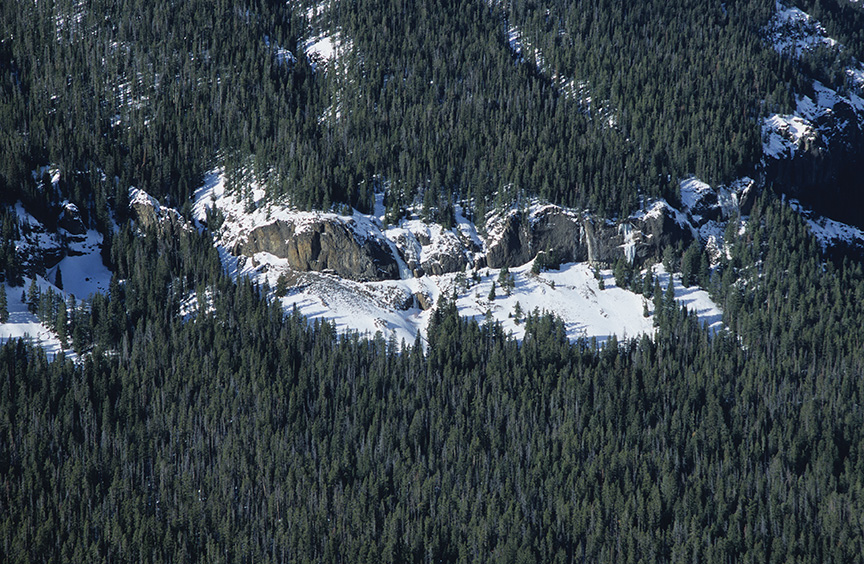 Unnamed Wall sports several clinic areas during the fest.
Unnamed Wall sports several clinic areas during the fest.
Black Magic Wall. Right of the Ice Festival clinic route Magically Delicious, the wall gets considerably steeper and longer. This area is also known as the “Black Magic Wall” after the best route in the canyon found here. If formed, the thin ice and mixed routes will be obvious and easily visible from the parking lot. If they are in before the new year, it is generally considered a once-every-decade sort of season. A number of drytooling routes (up to M11) are also found in the area and are climbable anytime.
Areas 3 & 4: Mummy & Amphitheater.
For years, Mummy Cooler 2 (WI 3) and The Scepter (WI 5) have been merit badges for all ice aficionados, local and visitor alike. Over the past decade, the routes lurking right of Mummy 2 have become very popular and worth a visit.
Approach. There is a new approach to The Scepter leading directly from The Scottish Cliff near G1, but to reach the routes right of Mummy 2, it is probably quickest to follow the traditional approach by walking up and left of the Amphitheater Cliff. Either approach should take about 45 minutes from the parking lot.
Ice Fest Locations. The Ice Fest has two locations in this area and will occupy the entire Amphitheater area (exclusive of Mummy Cooler 1) and the Mummy 2 / Scepter complex. Our location guides will determine which is the best approach to Mummy 2 / Scepter based on conditions.
Other Routes. The routes right of Mummy Cooler 2 are often overlooked despite providing a convenient location to tick off two or three in a modest day. These were poorly described in the guidebook Winter Dance because the book was written before road-plowing began. Now, with easy access until the end of March, we’ve learned that while sometimes thin, and sometimes fat, these routes are always fun. The routes are found at the same level as Mummy Cooler 2 and above the approach when coming from the Amphitheater. Here’s a description from left to right.
Crypt Orchid (60m, WI 2). If covered with snow, it might not look like much, but this big blue flow from a deep gash can be fun.
The Matrix (45m, M4 to WI 4). One of the best routes in Hyalite. Start in the big cave and climb a mixed step or a fat pillar to a narrow, steep finish.
Pika’s Perch (60m, WI 3). Mistakenly called Cave and Gully in Winter Dance, this tiered romp forms over the longest part of the cliff.
Feeding the Cat (25m, WI 3+). Immediately right of Pika, this route’s rare moss top-out can make for an exciting finish.

